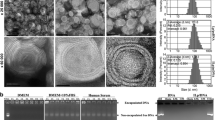Abstract
Purpose. In order to improve the in vitro and in vivo efficacy of an integrin antagonist (IA) of the extracellular domain of the αvβ3 integrin, a receptor upregulated on tumor neovasculature, the IA was attached to the surface of a dextran-coated liposome (DCL). IA-DCLs were characterized in vitro, and the pharmacokinetic and anti-tumor properties were assessed in vivo.
Methods. The in vitro binding properties were measured with purified integrin, endothelial cells, and melanoma cells. The pharmacokinetic parameters were measured in healthy mice with 14C-labeled IA-DCLs and anti-tumor efficacy was assessed with the M21 human melanoma xenograft mouse model.
Results. In vitro, IC50 values for IA-DCLs and IA are similar, and IA-DCLs inhibit cell proliferation relative to controls. IA-DCLs are stable in serum, and the pharmacokinetic half-life in mice is 23 h. In the M21/mouse model, statistically significant inhibition of tumor growth was observed for mice treated with IA-DCLs, whereas controls including saline, DCLs lacking IA, and cyclo(RGDfV) were ineffective. Increased apoptosis and a reduction in vessel counts relative to controls were present in tumors from animals treated with IA-DCLs.
Conclusions. These results demonstrate that IA-DCLs are potent anti-angiogenic therapeutic agents with superior in vivo activity and pharmacology compared to unmodified IA.
Similar content being viewed by others
REFERENCES
J. C. Gutheil, T. N. Campbell, P. R. Pierce, J. D. Watkins, W. D. Huse, D. J. Bodkin, and D. A. Cheresh. Targeted antiangiogenic therapy for cancer using Vitaxin: a humanized monoclonal anti-body to the integrin _v_3. Clin. Cancer Res. 6:3056–3061(2000).
C. L. Gladson. Expression of integrin _v_3 in small blood vessels of glioblastoma tumors. J. Neuropathol. Exp. Neuro. 55:1143–1149 (1996).
R. Max, R. R. Gerritsen, P. T. Nooijen, S. L. Goodman, A. Sutter, U. Keilholz, D. J. Ruiter, and R. M. De Waal. Immunohistochem-ical analysis of integrin _v_3 expression on tumor-associated ves-sels of human carcinomas. Int. J. Cancer 71:320–324 (1997).
L. Bello, J. Zhang, D. C. Nikas, J. F. Strasser, R. M. Villani, D. A. Cheresh, R. S. Carroll, and P. M. Black. _v_3 and _v_5 integrin expression in meningiomas. Neurosurgery 47:1185–1195 (2000).
J. D. Hood and D. A. Cheresh. Role of integrins in cell invasion and migration. Nat. Rev. Cancer 2:91–100 (2002).
J. S. Kerr, A. M. Slee, and S. A. Mousa. Small molecule alpha v integrin antagonists: novel anticancer agents. Expert Opin. Inves-tig. Drugs 9:1271–1279(2000).
J. S. Kerr, A. M. Slee, and S. A. Mousa. The alpha v integrin antagonists as novel anticancer agents: an update. Expert Opin. Investig. Drugs 11:1765–1774 (2002).
N. Oku, Y. Tokudome, C. Koike, N. Nishikawa, H. Mori, I. Saiki, and S. Okada. Liposomal Arg-Gly-Asp analogs effectively inhibit metastatic B16 melanoma colonization in murine lungs. Life Sci. 58:2263–2270 (1996).
K. Kurohane, Y. Namba, and N. Oku. Liposomes modified with a synthetic Arg-Gly-Asp mimetic inhibit lung metastasis of B16BL6 melanoma cells. Life Sci. 68:273–281 (2000).
R. Schiffelers, G. Molema, T. L. ten Hagen, A. P. Janssen, A. J. Schraa, R. J. Kok, G. A. Koning, and G. Storm. Ligand-targeted liposomes directed against pathological vasculature. J. Liposome Res. 12:129–135 (2002).
T. M. Allen. Liposomal drug formulations. Rationale for devel-opment and what we can expect for the future. Drugs 56:747–756 (1998).
R. Mehvar. Dextrans for targeted and sustained delivery of thera-peutic and imaging agents. J. Control. Rel. 69:1–25 (2000).
J. D. Hood, M. Bednarski, R. Frausto, S. Guccione, R. A. Reis-feld, R. Xiang, and D. A. Cheresh. Tumor regression by targeted gene delivery to the neovasculature. Science 296:2404–2407 (2002).
P. Hubert, J. Mester, E. Dellacherie, J. Neel, and E. E. Baulieu. Soluble biospecific macromolecule for purification of estrogen receptor. Proc. Natl. Acad. Sci. USA 75:3143–3147 (1978).
A. F. Habeeb. Determination of free amino groups in proteins by trinitrobenzenesulfonic acid. Anal. Biochem. 14:328–336(1966).
T. A. Scott and E. H. Melvin. Determination of dextran with anthrone. Anal. Chem. 25:1656–1661 (1953).
G. A. Sulyok, C. Gibson, S. L. Goodman, G. Holzemann, M. Wiesner, and H. Kessler. Solid-phase synthesis of a nonpeptide RGD mimetic library: new selective _v_3 integrin antagonists. J. Med. Chem. 44:1938–1950 (2001).
J. M. Wu, M. P. Rosser, A. R. Howlett, and R. I. Feldman. In A. Howlett (ed.), Integrin Protocols, Humana Press, Totowa, NJ, 1999 pp. 211–217.
R. D. Petty, L. A. Sutherland, E. M. Hunter, and I. A. Cree. Comparison of MTT and ATP-based assays for the measurement of viable cell number. J. Biolumin. Chemilumin. 10:29–34 (1995).
I. M. Hann and H. G. Prentice. Lipid-based amphotericin B: a review of the last 10 years of use. Int. J. Antimicrob. Agents 17:161–169 (2001).
H. M. Patel, N. S. Tuzel, and B. E. Ryman. Inhibitory effect of cholesterol on the uptake of liposomes by liver and spleen. Bio-chim. Biophys. Acta 761:142–151 (1983).
D. L. Iden and T. M. Allen. In vitro and in vivo comparison of immunoliposomes made by conventional coupling techniques with those made by a new post-insertion approach. Biochim. Bio-phys. Acta 1513:207–216 (2001).
B. S. Coller, K. Anderson, and H. F. Weisman. New antiplatelet agents: platelet GPIIb/IIIa antagonists. Thromb. Haemost. 74: 302–308 (1995).
T. M. Allen and C. Hansen. Pharmacokinetics of stealth versus conventional liposomes: effect of dose. Biochim. Biophys. Acta 1068:133–141 (1991).
S. Chatterjee, A. Matsumura, J. Schradermeier, and G. Y. Gillespie. Human malignant glioma therapy using anti-_v_3 in-tegrin agents. J. Neurooncol. 46:135–144 (2000).
J. Haier, U. Goldmann, B. Hotz, N. Runkel, and U. Keilholz. Inhibition of tumor progression and neoangiogenesis using cyclic RGD-peptides in a chemically induced colon carcinoma in rats. Clin. Exp. Metastasis 19:665–672 (2002).
R. Allman, P. Cowburn, and M. Mason. In vitro and in vivo effects of a cyclic peptide with affinity for the alpha v beta 3 integrin in human melanoma cells. Eur. J. Cancer 36:410–422 (2000).
Author information
Authors and Affiliations
Rights and permissions
About this article
Cite this article
Wartchow, C.A., Alters, S.E., Garzone, P.D. et al. Enhancement of the Efficacy of An Antagonist of an Extracellular Receptor by Attachment to the Surface of a Biocompatible Carrier. Pharm Res 21, 1880–1885 (2004). https://doi.org/10.1023/B:PHAM.0000045243.98010.b6
Issue Date:
DOI: https://doi.org/10.1023/B:PHAM.0000045243.98010.b6




